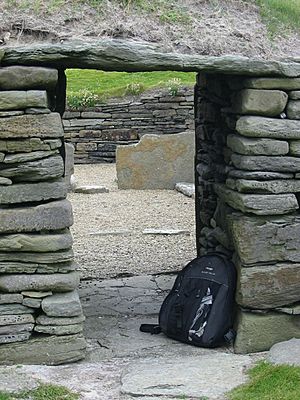Knap of Howar facts for kids
The Knap of Howar is a very old farm on the island of Papa Westray in Orkney, Scotland. It is a Neolithic farmstead, which means it was built during the New Stone Age. This makes it possibly the oldest stone house still standing in northern Europe!
Scientists used a method called radiocarbon dating to find out its age. They learned that people lived here from about 3700 BC to 2800 BC. This was even earlier than the famous houses at Skara Brae on the Orkney Mainland.
The Ancient Farmstead
The farm at Knap of Howar has two buildings. They are shaped like rounded rectangles and have very thick walls. Their doorways are quite low and face towards the sea.
The larger building is also the older one. It is connected to the other building by a low, short passage. The second building might have been a workshop or another house. These buildings were built on top of an old midden. A midden is like an ancient trash pile. The midden material around the buildings helped protect them over thousands of years.
The houses did not have any windows. People probably used fire for light inside. There would have been a hole in the roof to let the smoke out. Today, the buildings are very close to the shore. But when they were first built, they were further inland. The local stone splits easily into thin slabs. This made it a perfect material for building these strong houses.
The walls of the buildings are still about 1.6 meters (5 feet) high. The stone furniture inside is still there, too! This helps us imagine what life was like in the house. You can still see fireplaces, stone screens that divided rooms, beds, and shelves. There were also holes in the ground where wooden posts once stood, supporting the roof.
Life at Knap of Howar
Scientists found clues in the middens (trash piles) around the farm. These clues tell us a lot about the people who lived there. They kept cattle, sheep, and pigs for food. They also grew crops like barley and wheat.
The people also gathered shellfish from the sea. They went fishing for different kinds of fish. They would have used lines and boats to catch these fish.
Archaeologists also found special pottery called Unstan ware. This pottery was very well-made and had beautiful decorations. Finding this pottery links the people of Knap of Howar to nearby chambered cairn tombs. It also connects them to other ancient sites far away, like Balbridie and Eilean Domhnuill.
The name "Howar" comes from an old language called Old Norse. The word haugr in Old Norse means "mounds" or "barrows".
Today, the site is looked after by Historic Scotland.
Images for kids
See also
 In Spanish: Knap de Howar para niños
In Spanish: Knap de Howar para niños




